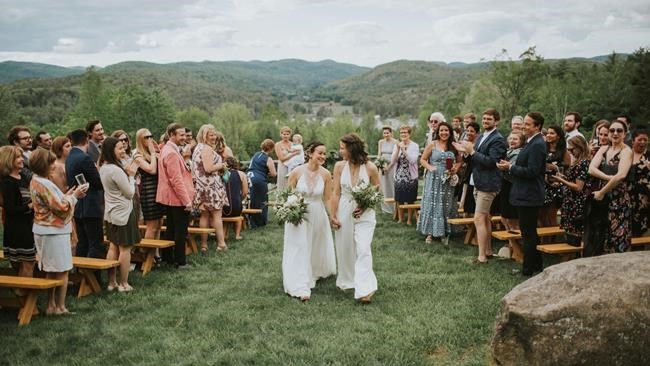
In this May 28, 2017 photo provided by Jamie Mercurio, Lib Tietjen, right, and her wife, Claire Skrivanos, walk up the aisle after their wedding ceremony in Fairlee, Vt. Traditional weddings are deeply rooted in gender-based rituals. But the growing LGBTQ wedding industry is coming up with new approaches. Many couples are engaging with centuries of tradition but crafting their own way to the altar. (Jamie Mercurio/Jamie Mercurio Photography via AP)
Republished April 10, 2018 - 1:49 PM
Original Publication Date April 10, 2018 - 6:46 AM
Traditional weddings are deeply rooted in gender-based rituals, but the growing LGBTQ wedding industry is reimagining that. Many couples are engaging with centuries of tradition but crafting their own way to the altar.
"Structurally, what is required in the wedding planning process is the same," says Kathryn Hamm, an education and diversity specialist at WeddingWire.com , "but because traditionally speaking, the gender roles in weddings are so deeply engrained, there is a very concrete necessity for two grooms or two brides to figure out how to plan within that schema."
So how is it decided who does what in LGBTQ weddings?
Unsurprisingly, there's no single answer. Because they can't adhere to gender norms, LGBTQ couples can be creative. Many are putting a new focus on equality between the two people getting married.
"It's very freeing from the idea that there are these rules, and you must do this and you must do that," says Kirsten Palladino, founder of the LGBTQ wedding website EquallyWed.com. Among the innovations Palladino has seen are trains sewn into grooms' tuxedos, drag-queen flower girls, and a double aisle, so both marriers can walk at once and "not one of them comes first or second," she says.
Proposals are planned based on what makes sense for the couple. Lib Tietjen and Claire Skrivanos, who married in Fairlee, Vermont, in May 2017, purchased their engagement rings together. Tietjen later proposed to Skrivanos, beating her by a week in what they deemed a friendly competition for who would pop the question first.
"It hadn't really occurred to me how engrained the script of a wedding was," says Tietjen. "There was something really freeing and also really terrifying about knowing you got to do an entirely different script."
In their wedding, Tietjen and Skirvanos didn't want it to appear that either of them was playing the man's or woman's role. "We walked down the aisle together," Tietjen says. "We didn't want our fathers to give us away. No one was giving us to anyone. We were giving ourselves to each other."
PJ Painter and Ryan Bedinghaus, who will marry in August in Louisville, Kentucky, have similar concerns and hope to avoid any illusion of gender roles in their ceremony. "I think there's a general mindset that whoever is in the lighter colour clothing is the woman in the relationship," says Painter, "which we obviously don't want to portray because there is no woman in our relationship. So we decided to wear the same colour suit."
Painter and Bedinghaus will have three aisles: the middle one for their wedding party, and two outer aisles they will walk down at the same time. They will have both men and women standing up for them.
Hamm says the trend of mixed-gender wedding parties is growing in heterosexual weddings as well as LGBTQ ones. According to WeddingWire, the number of straight couples dividing weddings by gender has dropped 14 per cent since 2015. "To me," Hamm says, "This is a really clear example of straight people attending same-sex weddings and saying, 'I can do that too.'"
Stripping away gender norms, however, doesn't necessarily mean tossing out tradition. Plenty of LGBTQ couples still want traditional weddings. For instance, Palladino says, "a mother-son dance is maybe just a parent-child dance."
"I think straight readers would be surprised just how traditional most LGBTQ couples are," she says. "They're just two people committing their lives to one another in front of the people they love and respect."
And LGBTQ weddings are contributing to a trend in which many couples of all sexualities are thinking hard about the reasons behind rituals.
Millennials as a whole have shown a strong desire for more customized weddings, industry experts say, although planning a traditional wedding also remains popular. "We just want people to have a choice," Hamm says.
If you peruse Google for what LGBTQ couples are asking about their weddings and engagements, you'll find inquiries like, do gay men wear engagement rings? How do you know who proposes? Who pays for what?
Hamm's advice is the same for both heterosexual and LGBTQ couples: Do what you want.
Palladino agrees. "The only thing you must do is send out thank you notes," she says. "Everything else is up to you."
News from © The Associated Press, 2018